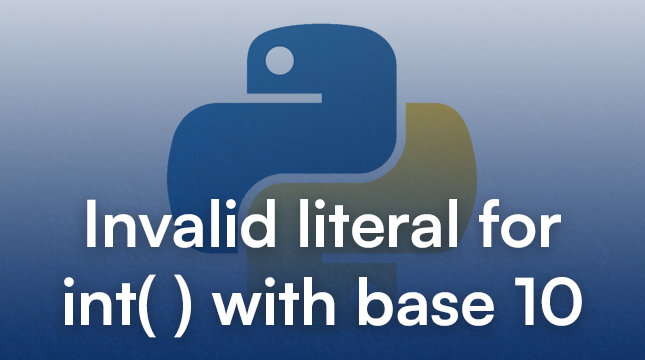This website uses cookies so that we can provide you with the best user experience possible. Cookie information is stored in your browser and performs functions such as recognising you when you return to our website and helping our team to understand which sections of the website you find most interesting and useful.
Understanding and Fixing “Invalid Literal for int() with Base 10” in Python

Hey fellow Python devs, have you ever been knee-deep in coding, maybe building a simple script to process some user data, and suddenly BAM, your terminal spits out “ValueError: invalid literal for int() with base 10”? If you’re nodding along, you’re not alone.
This error is one of those sneaky gotchas that trips up beginners and pros alike. It’s basically Python’s way of saying, “Hey, I can’t turn this string into an integer because it’s not a valid number in base 10.”
In this post, we’re diving deep into the “invalid literal for int with base 10” Python error. I’ll explain what it really means, why it happens, and most importantly, how to fix it with real examples from my own coding mishaps.
Whether you’re parsing input from a console app or cleaning data from a file, by the end, you’ll have the tools to squash this bug for good. Let’s get into it.
Understanding the Error
At its core, this error pops up when you call Python’s built-in int() function on a string that isn’t a pure integer representation in base 10 (that’s decimal, the numbering system we use every day). The full error message usually looks like this: ValueError: invalid literal for int() with base 10: ‘your_invalid_string’.
What’s a “literal”? In Python, it just means the raw value you’re trying to convert. And “base 10” specifies the numeral system, think 0-9 digits only, no letters or special chars unless you’re using a different base like hex (base 16).
This happens because int() is strict. It expects something like ’42’ or ‘100’, but if you feed it ’42a’, ‘3.14’, or even an empty string ”, it freaks out. For instance, imagine you’re writing a script to calculate someone’s age based on input:
# User types 'twenty-five' by mistake
user_input = input("Enter your age: ")
age = int(user_input) # Boom! ValueError: invalid literal for int() with base 10: 'twenty-five'
Output:
Traceback (most recent call last):
File “<stdin>”, line 2, in <module>
ValueError: invalid literal for int() with base 10: ‘twenty-five’
See? In real life, users don’t always follow instructions. This error is super common in scenarios involving external data, like reading from files or APIs, where strings might not be sanitized.
Common Causes of the Error
Let’s break down why this error loves to crash the party. I’ve seen these in my projects, from simple CLI tools to data processing pipelines.
Unvalidated User Input
People type all sorts of junk. If you’re using input() without checks, you’re asking for trouble.
Example: In a budget tracker app, you ask for an expense amount.
# User enters '50.00' thinking it's fine
expense = input("Enter expense amount: ")
total = int(expense) # Error: invalid literal for int() with base 10: '50.00'
Parsing Messy Data from Files
CSV files or JSON often have strings that look numeric but aren’t. Maybe there’s a comma or a space.
Real example from a CSV reader I built for sales data:
import csv
with open('sales.csv', 'r') as file:
reader = csv.reader(file)
for row in reader:
quantity = int(row[2]) # If row[2] is ' 10 ' (with spaces), it fails: invalid literal for int() with base 10: ' 10 '
Strings with Non-Digit Characters
Anything extra, like letters, decimals, or symbols, breaks it.
From a web scraper pulling product IDs:
# Scraped from a site
product_id_str = 'ID-123'
product_id = int(product_id_str) # Error: invalid literal for int() with base 10: 'ID-123'
Empty or None Values
Converting an empty string or something that’s not even a string.
In a loop processing form data:
# Maybe a blank field
form_data = ''
value = int(form_data) # Error: invalid literal for int() with base 10: ''
These are pulled straight from bugs I’ve debugged—trust me, they feel all too real when your code halts midway.
How to Debug and Fix the Error
Debugging this is straightforward once you know where to look. Start by printing the variable right before the int() call: print(repr(your_string))—the repr() shows hidden chars like spaces.
For fixes, here’s a step-by-step approach with code.
Use Try-Except Blocks
Catch the error and handle it gracefully.
Fixed version of the age input:
user_input = input("Enter your age: ")
try:
age = int(user_input)
except ValueError:
print("Oops! That's not a valid number. Please enter digits only.")
age = 0 # Or prompt again
Validate with .isdigit()
Check if it’s all digits.
For the expense example:
expense = input("Enter expense amount: ").strip() # Remove spaces
if expense.isdigit():
total = int(expense)
else:
print("Invalid input. Use whole numbers only.")
total = 0
Handle Floats Separately
If decimals are possible, use float() first or round.
expense = '50.00'
try:
total = int(float(expense)) # Converts to 50
except ValueError:
print("Not a valid number.")
Clean the String
Strip whitespace or remove non-digits with regex.
For the CSV issue:
import re
quantity_str = row[2].strip()
quantity_str = re.sub(r'\D', '', quantity_str) # Remove non-digits
if quantity_str:
quantity = int(quantity_str)
else:
quantity = 0
These tweaks have saved me hours—try them in your own code.
Best Practices to Avoid the Error
Prevention is better than cure, right? Here are habits I’ve adopted to keep this error at bay.
Always Validate Input Early: Use libraries like Pydantic for structured data or just simple checks.
Write a Safe Conversion Function
def safe_int_convert(value, default=0):
try:
return int(value)
except ValueError:
print(f"Invalid int: {value}. Using default {default}.")
return default
# Usage: age = safe_int_convert(user_input)
Leverage Pandas for Data
If dealing with tables, let pandas handle conversions.
import pandas as pd
df = pd.read_csv('sales.csv')
df['quantity'] = pd.to_numeric(df['quantity'], errors='coerce').fillna(0).astype(int)
Test with Edge Cases: Feed your code empty strings, floats, letters—make sure it doesn’t crash.
For API work, always assume incoming data is dirty and sanitize it first.
Advanced Scenarios and Related Errors
In bigger projects, this error can hide in loops or large datasets. For example, processing a list of IDs from a database query, if one is malformed, your whole script stops. Use list comprehensions with try-except to filter them.
Related to other bases: If you’re doing hex conversions with int(‘abc’, 16), an invalid char gives a similar error, but for base 16. Stick to base 10 unless needed.
Real case from a Flask web app I built: Users submit forms with ages. One typo, like ’30 years,’ crashed the endpoint. Fixed with validation middleware.
from flask import Flask, request
app = Flask(__name__)
@app.route('/submit', methods=['POST'])
def submit():
age_str = request.form.get('age', '').strip()
if age_str.isdigit():
age = int(age_str)
return f"Age recorded: {age}"
else:
return "Invalid age format.", 400
Stuff like this makes your apps robust for real users.
Also Read
Convert an integer to a string in Python
Python switch statement
JavaScript vs Python
Conclusion
Wrapping up, the “invalid literal for int with base 10 python” error is all about mismatched expectations when converting strings to ints. By understanding its causes, like dirty inputs or non-numeric chars, and using fixes like try-except, validation, and cleaning, you can avoid it entirely. Remember those examples; tweak them for your code, and you’ll be golden.

Let's Start Your Project
Get free consultation for your digital product idea to turn it into reality!
Get Started






